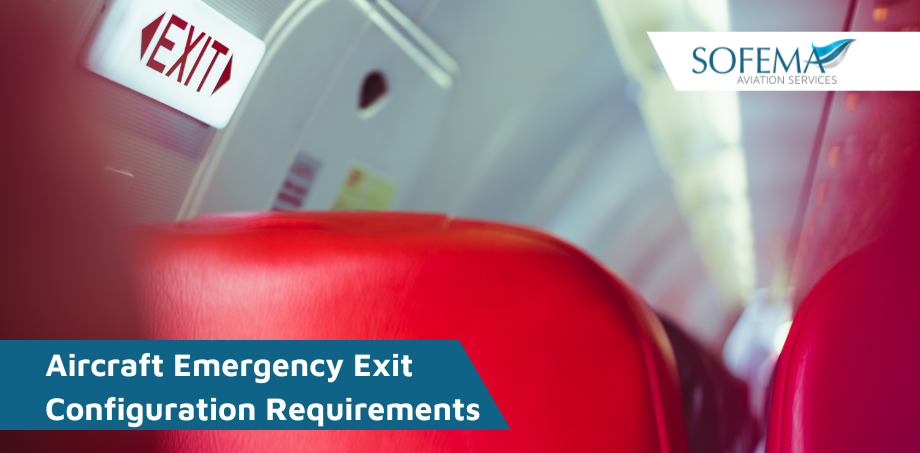Sofema Aviation Services (SAS) www.sassofia.com considers the requirements related to various Emergency Exit Configurations.
Introduction Exit Requirements per Passenger Configuration
For a passenger seating configuration of 1 to 9 seats, there must be at least one Type IV or larger over wing exit on each side of the fuselage or,
- if over wing exits are not provided, at least one exit on each side that meets the minimum dimensions of a Type III exit.
For a passenger seating configuration of more than 9 seats, each exit must be a Type III or larger exit.
For a passenger seating configuration of 10 to 19 seats, there must be at least one Type III or larger exit on each side of the fuselage.
For a passenger seating configuration of 20 to 40 seats, there must be at least two exits, one of which must be a Type II or larger exit, on each side of the fuselage.
For a passenger seating configuration of 41 to 110 seats, there must be at least two exits, one of which must be a Type I or larger exit, on each side of the fuselage.
For a passenger seating configuration of more than 110 seats, the emergency exits on each side of the fuselage must include at least two Type I or larger exits.
- Note: The combined maximum number of passenger seats permitted for all Type III exits is 70, and the combined maximum number of passenger seats permitted for two Type III exits on each side of the fuselage that is separated by fewer than three passenger seat rows is 65.
If a Type A, Type B, or Type C exit is installed, there must be at least two Type C or larger exits on each side of the fuselage.
If a passenger ventral or tailcone exit is installed and that exit provides at least the same rate of egress as a Type III exit with the airplane in the most adverse exit opening condition that would result from the collapse of one or more legs of the landing gear, an increase in the passenger seating configuration is permitted as follows:
- For a ventral exit, 12 additional passenger seats.
- For a tail cone exit incorporating a floor level opening of not less than 20 inches wide by 60 inches high, with corner radii not greater than seven inches, in the pressure shell and incorporating an approved assist means in accordance with 25.810(a), 25 additional passenger seats.
- For a tail cone exit incorporating an opening in the pressure shell which is at least equivalent to a Type III emergency exit with respect to dimensions, step-up and step-down distance, and with the top of the opening not less than 56 inches from the passenger compartment floor, 15 additional passenger seats.
Other exits. The following exits also must meet the applicable emergency exit requirements of 25.809 through 25.812, and must be readily accessible:
- Each emergency exit in the passenger compartment in excess of the minimum number of required emergency exits.
- Any other floor-level door or exit that is accessible from the passenger compartment and is as large or larger than a Type II exit, but less than 46 inches wide.
Any other ventral or tail cone passenger exit.
- Ditching emergency exits for passengers. Whether or not ditching certification is requested, ditching emergency exits must be provided in accordance with the following requirements, (unless the emergency exits required by this section already meet the requirement)
o For airplanes that have a passenger seating configuration of nine or fewer seats, excluding pilot seats, one exit above the waterline in each side of the airplane, meeting at least the dimensions of a Type IV exit.
o For airplanes that have a passenger seating configuration of 10 of more seats, excluding pilot seats, one exit above the waterline in a side of the airplane, meeting at least the dimensions of a Type III exit for each unit (or part of a unit) of 35 passenger seats, but no less than two such exits in the passenger cabin, with one on each side of the airplane.
o The passenger seat/ exit ratio may be increased through the use of larger exits, or other means, provided it is shown that the evacuation capability during ditching has been improved accordingly.
Note: If it is impractical to locate side exits above the waterline, the side exits must be replaced by an equal number of readily accessible overhead hatches of not less than the dimensions of a Type III exit, except that for airplanes with a passenger configuration of 35 or fewer seats, excluding pilot seats, the two required Type III side exits need be replaced by only one overhead hatch.
Flight crew emergency exits.
For airplanes in which the proximity of passenger emergency exits to the flight crew area does not offer a convenient and readily accessible means of evacuation of the flight crew, and for all airplanes having a passenger seating capacity greater than 20, flight crew exits shall be located in the flight crew area. Such exits shall be of sufficient size and so located as to permit rapid evacuation by the crew.
- One exit shall be provided on each side of the airplane; or, alternatively, a top hatch shall be provided. Each exit must encompass an unobstructed rectangular opening of at least 19 by 20 inches unless satisfactory exit utility can be demonstrated by a typical crewmember.
Next Steps
Follow this link to our Library to find & Download related documents for Free.
Sofema Aviation Services (SAS) provides Consultancy, Classroom, Webinar and Online Training including a 5-day EASA CS 25 Compliant Cabin Certification & Mods Training Program.
For additional details, please see our websites www.sassofia.com and www.sofemaonline.com or email team@sassofia.com
Tags:
Aircraft, aviation, Aviation Training, Compliance, EASA, EASA compliant, Flight Crew, Aviation Competence, Cabin Certification, emergency, Seat Certification, Exit Configurations, Emergency Exit





